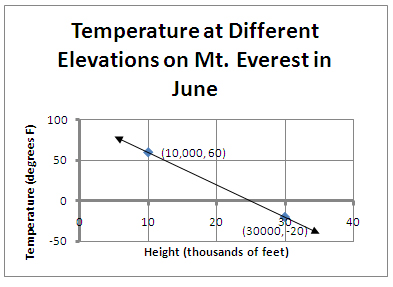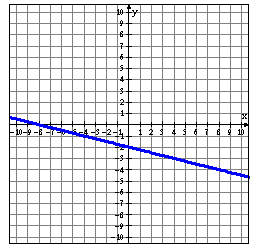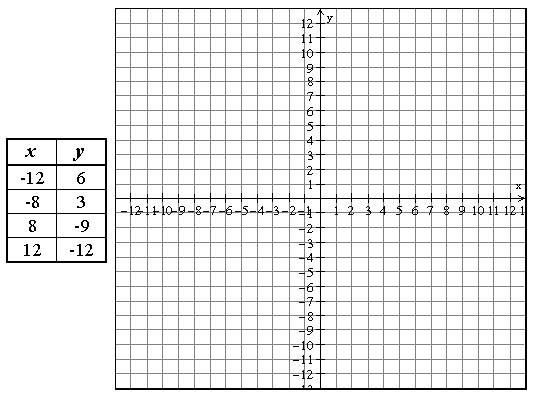Janice took two temperature readings at different elevations, heights, on Mt. Everest in June. She developed a linear model to show the relationship between height, or elevation above sea level (0 feet), and air temperature. According to the model, what would be the height when the air temperature is 0°F?

A. 25,000 ft
Correct! At 25,000 feet the temperature is 0°F.
B. 35,000 ft
Incorrect. Don’t be tricked by an arrow. At 35,000 feet the temperature is -40°F.
C. 40,000 ft
Incorrect. The bottom line does not represent 0°F; it’s -60°F. At 40,000 feet the temperature is -60°F.
D. 100,000 ft
Incorrect. Don’t be tricked by the y-intercept value. 100,000 feet is not on the graph.
What are the x- and y-intercepts of the function graphed below?

A. (-8, 0) and (-2, 0)
Incorrect. (#, 0) only represents x-intercepts (zero).
B. (-8, 0) and (0, -2)
Correct! -8 is the x-intercept and -2 is the y-intercept.
C. (0, -8) and (-2, 0)
Incorrect. You should look at an ordered pair and think (x, y) and the -8 is the x because it’s on the x-axis.
D. (0, -8) and (0, -2)
Incorrect. (0, #) only represents y-intercepts.
Which of the following ordered pairs is the x-intercept or the y-intercept of the function 3x − y = 9?
A. (9, 0)
Incorrect. Remember that an ordered pair is (x, y), so 9 is the x. 3(9) − 0.
B. (0, 3)
Incorrect. Remember that an ordered pair is (x, y), so 0 is the x, 3 is the y, and 3(0) = 0.
C. (3, 0)
Correct! It’s the 3 that represents the x and (3, 0) is the functions x-intercept.
D. (0, 9)
Incorrect. You missed the – sign. -9 does not equal 9.
The ordered pairs in the table are contained in the graph of a linear function. What are the x- and y-intercepts of the graph of this linear function?

A. Incorrect. Plot the points and label your axes.
B. Incorrect. The labels are switched. The x-intercept has a number for the x-value, (#, 0), and the y-value is 0. Check your graph.
C. Incorrect. The labels are switched. The x-intercept has a number for the x-value, (#, 0), and the y-value is 0. Check your graph.
D. Correct! The x-intercept is -4 and the y-intercept is -3.
What is the y-intercept of the function f(x) = 2(x − 1)?
A. 2
Incorrect. A y-intercept is when x = 0, (0, #). Be careful with distributing the 2. You can always plug in the 0 for x and solve using order of operations.
B. 1
Incorrect. A y-intercept is when x = 0, (0, #). Be careful with distributing the 2. You can always plug in the 0 for x and solve using order of operations.
C. -1
Incorrect. This is not y-intercept form. Make sure you check by plugging in 0 for x.
D. -2
Correct! Did you check your answers two ways? On this problem you could distribute the 2 to write the equation is slope intercept form or plug in 0 for x.